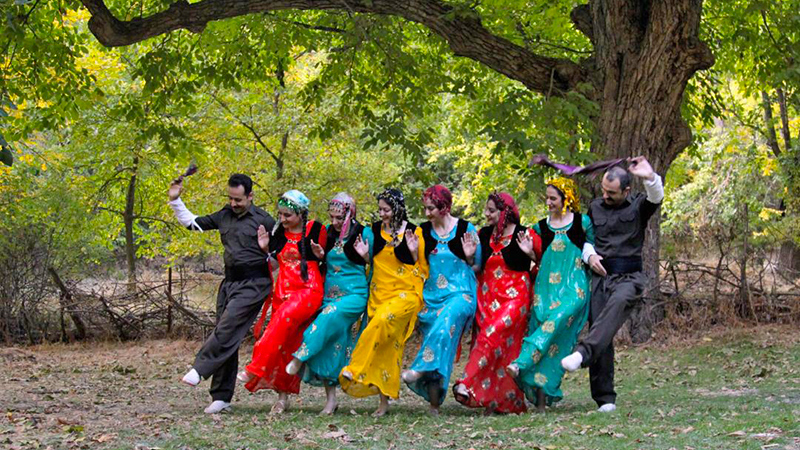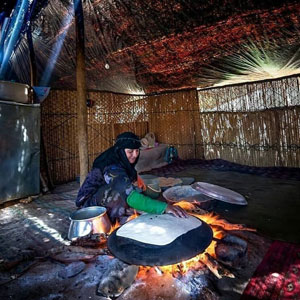 Signin with Google
Signin with Google Signin with Facebook
Signin with Facebook Culture
CultureHalparke Dance, Born of Kurdish Myths

Helparke Dancers, the Guardians of Kurdish Legacy
When Serchupi, the leader, spins his handkerchief with his right hand, man and woman moving smoothly around hand in hand in a circle with the rhythmic music, it seems that the whole universe is dancing cheerfully with them. The only apprehension of this happy circle moving their shoulders and legs in harmony is to have a sterling performance. This dance is a part of their long history as a large and unit family for them, the Kurds.
Passion simmers and grief flees
The vast land between Iran, Iraq, Turkey, Syria, and Armenia has been the homeland of Kurds for thousands of years. Long before the Islamic conquests of the 7th century, this nation inhabited the mountainous western regions of Iran, Kurdistan, Kermanshah, West Azerbaijan, and Ilam Provinces. And today, they are the third-largest ethnic group in the country.
As an ancient ethnic group, they have their own culture, language, and beliefs. Their energetic rhythmical dance is a glitter of their deep roots and original way of living.
The excavated objects and inscription on archaeological sites' hearts shows that singing and dancing was a perpetual part of the Kurds’ festivals and ceremonies, especially for Nowruz. Unlike Islamic religious prohibitions, Kurdish dance has not waned over the years for its profound depth. Dance or as the Kurds call it "Halparke" is not just a set of vigorous but meaningless movements. It is the essence of Kurdish mythology, art, and beliefs. Kurds express their feelings through Halparke. They stand side by side and dance in weddings, during harvest time, in case of having a dear guest, even in mourning ceremonies to show their respect.

Fair Report on the war by dancing!
There is an interesting story about the origin of Kurdish dance that relates this dance to martial arts. It was said that once a commander came at the presence of the Median King to give a report of their victory at the war. The commander, known as Chupi Kesh or Sarchupi, used a red handkerchief instead of a sword and stood beside his soldiers taking each other's hands as a symbol of solidarity and loyalty.
They started with a slow dance to show that they started the war gently. Then the commander accelerated the rhythm, and this meant that we quickly attacked the enemy. They moved one step backwards and two steps forward quickly to represent their retreats and advances in the battle. In another move, Sarchupi limped off with his right leg but then suddenly fluttered, which means that if we were wounded on the battlefield, we recover very quickly and attack the enemy again. And he ended the performance by sitting to express that the enemy had surrendered.
Halparke, a symbolic dance roots in the passion
Halparke is a figurative performance. Each and every move of dancers has a thoughtful meaning. This folkloric dance is performed by a chain of men and women standing shoulder to shoulder in a semicircular form to show their unity as a group. In Kurdish dances, no one is at the centre, each member is equally important in this elegant show. Sometimes the lead dancer, Sarchupi, stands one step away from the group and do rhythmical moves and jumps while the other dancers, known as "Gawanís", follow their own patterns. In Halparke every one should be nimble and free like the wind in the handkerchief.
Sarchopi is the best dancer who determines the movements of the dance and others follow him or her. Usually, Sarchopi will not be replaced until the end of one circle. This shows the loyalty of the dancers to their leader.

Another point in Kurdish dance is the handkerchief in the hand of the lead dancer. It is a representation of a flying flag between earth and sky as an invitation for an uprising. Dancers stomp to revive the soil and the dancing circle is a symbol of the agricultural revolution when the months and seasons of the year return to the beginning.
Halparke is among a few mixed-gendered folkloric dances that both men and women enjoy doing and the presence of women in dances is a sign of their important role in Kurdish society.
Varieties of Kurdish Dance
Kurdistan is mush defined by traditions and culture rather than borders. In spite of the common features like standing in a line and holding hands, tying them across the lower back or interlacing pinky fingers, each tribe has its own signature in dance moves. Generally, women's dances are recognized by their smooth movements of shoulder and neck, men's dances have exciting and fast leg movements. The most well-practised types of Kurdish dances are Dilan, Chapi, Sorani, Sepe, Kurmanji, and Geryan.
Sorani is characterized by simple footsteps and continual swaying of body and shoulders. The basic move in Sepe and Chapi is moving two steps forward and retreated. In Kurmanji, dancers hold their bodies erectly and have impressive, vigorous movements. Geryan is the most rapid version of the Kurdish dance type.
Kurdish music
Kurdish dance and music are inseparable. The upbeat and ecstatic melodies stir you to join the company and dance with the rhythm. Tanbur lute, Daf Persian drum, Ney reed, Kamanche bowed string instrument and Sorna trumpet-like instrument are the most popular instruments in Kurdistan folk music.
Kurdish men and women are the real depositories of long years of culture and history. Women in their colourful customs and glittering jewellery among men with their simple dresses enhance the real beauty of Kurdish dance.
Seeing a group of happy men and women holding their hands, moving around with joyful music inspires you to join them. But before you come over your hesitation, these humble people gently invite you to share their happiness.
By Samaneh Zohrabi / TasteIran



